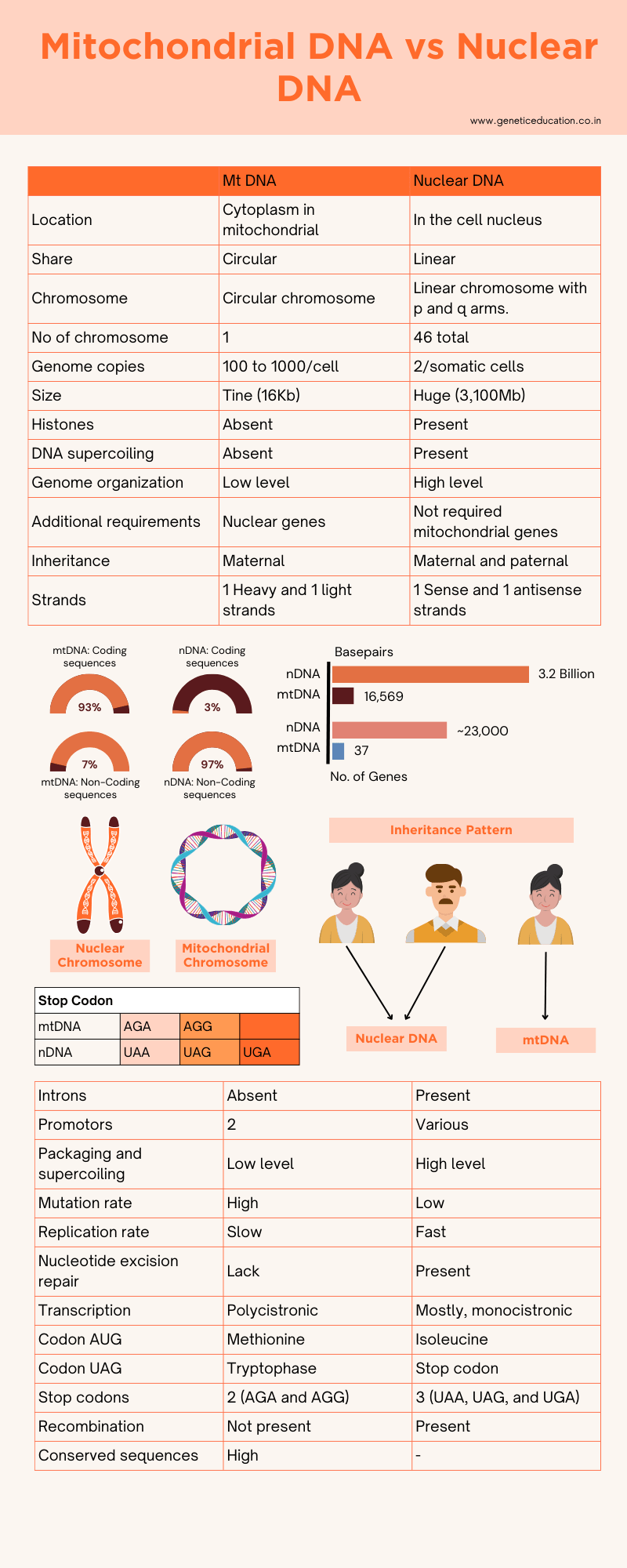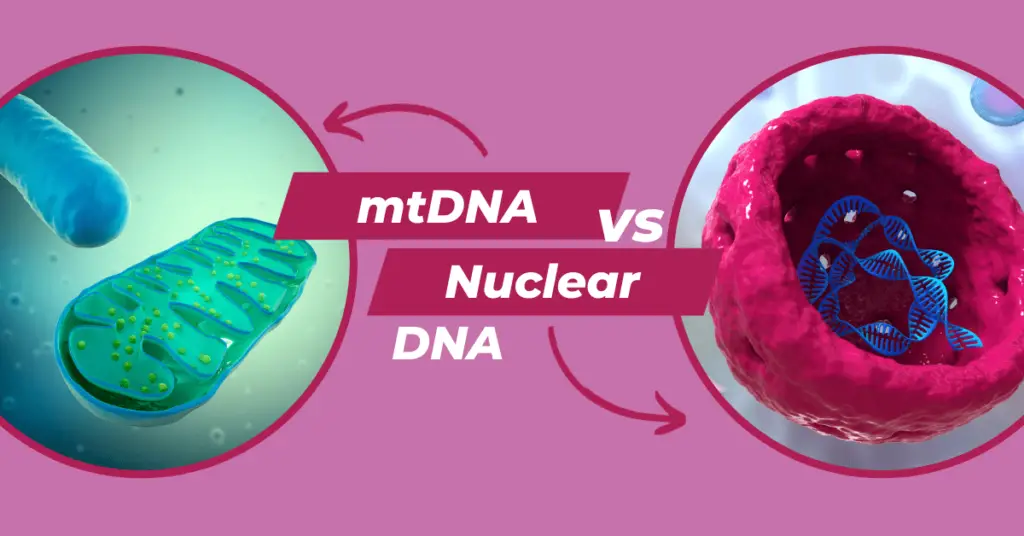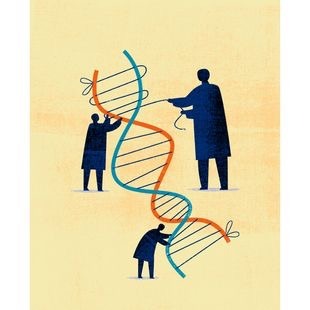“Learn about some of the crucial differences between and a few common similarities between mitochondrial DNA and nuclear DNA in the present article.”
DNA is a blueprint of our life. We all know that! Because it carries all the crucial information for our survival on Earth. The genes encode proteins while the non-coding DNAs regulate gene expression.
That set of DNA is located on 23 pairs of chromosomes situated in the cell nucleus. However, membrane-bounded organelles also contain their own DNA and so genes! For example the mitochondria.
Both nuclear and mitochondrial DNA are made up of nucleotides A, T, G and C, which follow replication, transcription, translation and produce proteins. But do you know, they are different in many ways!
The mitochondrial genome operates ‘almost’ autonomously within this tiny cellular place, distinct from the control of the nuclear genome! Let’s dive into the cell, and analyze the differences and similarities between mitochondrial DNA and nuclear DNA.
Stay tuned.
Related article: Organelle DNA- Mitochondrial and Chloroplast DNA.
Disclaimer: The content presented herein has been compiled from reputable, peer-reviewed sources and is presented in an easy-to-understand manner for better comprehension. A comprehensive list of sources is provided after the article for reference.
Key Topics:
Mitochondrial DNA vs Nuclear DNA- Differences

Let’s start with some common differences!
The most significant difference between the mitochondrial DNA and nuclear DNA is the location. Two distinct partitions of a cell are the cytoplasm and nucleus. The cytoplasm contains organelles whereas the nucleus contains the nucleic acid.
Mitochondria is located in the cell cytoplasm, thus, the mtDNA is situated in the cell cytoplasm whereas the nuclear DNA is located in the cell nucleus. mtDNA is, therefore, often called cytoplasmic DNA.
Nuclear DNA is linear in shape and located on chromosomes whereas mtDNA is circular in shape and contains only a single circular chromosome.
mtDNA is very tiny and contains only a few genes while the nuclear DNA is comparatively very huge and contains thousands of important genes.
The size of mtDNA is ~16KB and contains 16,569 base pairs. On the other hand, the size of the human genome is 3,100Mb and contains 3.2 billion base pairs.
The tiny-sized mitochondrial genome has 37 protein codings, contrary, the nuclear genome has 20,000 to 23,000 known protein coding genes.
Henceforth, nuclear DNA plays a pivotal and major role in one’s overall health and well-being but the mtDNA is majorly involved in oxidative phosphorylation and mtRNA metabolism.
Now let’s go more in-depth in the topic and understand more crucial differences.
Histones are the important structural architectural units of the chromosome foundation and help with DNA packaging. Interestingly, histones are not present in the mitochondrial chromosome.
Due to this reason, the nuclear DNA shows supercoiling and organized packaging that mtDNA lacks.
Studies also showed that mtDNA requires additional genes from the nuclear genome to perform various functions properly. However, nuclear DNA doesn’t require mitochondrial genes for better functionality.
‘Genome copy numbers’ are also an important differentiation factor in this comparison. The nuclear genome is diploid and comprises two copies. Conversely, mitochondrial genome copies vary from a few 100 to 1,000 in a single cell (and 5 to 10 per mitochondria).
Meaning, a single cell contains two copies of a nuclear DNA but 100 to 1,000 copies of a mitochondrial DNA. Note that germ cells carry a single copy of a nuclear genome. It’s interesting to know that the number of mtDNA copies varies among cell types and organisms.
An inheritance pattern also significantly differs between nuclear and mitochondrial DNA. Nuclear DNA is inherited from both maternal and paternal sides. Meaning, that the father contributes one copy and the mother contributes another copy.
Shockingly, the mtDNA has maternal inheritance only. Meaning, it is only transmitted from the mother’s side.
Both types of DNA are double-stranded and both trends are connected with hydrogen bonds. Nuclear DNA contains sense and antisense strands whereas mtDNA contains heavy and light chains. The heavy and light chains are classified based on the G+C content of the strand.
Heavy chain- high G+C content; Light chain- low G+C content.
The mitochondrial genome carries an independent machinery for DNA metabolism, however, it can’t independently synthesize its proteins. It heavily relies on the protein synthesized by the nuclear genome for such activities.
Contrary, a nuclear genome can independently perform replication, transcription and translation.
In addition to this, one point must be discussed here. For nuclear DNA, replication and transcription occur in the cell nucleus, and translation occurs in the cytoplasm, whereas in mtDNA, all three activities occur in the mitochondria.
Studies are evident that nuclear and mitochondrial genomes also differ in their genomic compositions. The major portion of the nuclear genome is made up of non-coding DNA, approximately 97%, it contains only 2 to 3% of coding genes.
Contrarily, the major portion of mitochondrial DNA is made up of coding DNA sequences, approximately 93% and a small portion contains non-coding DNA.
The existence of intronic noncoding sequences has been a distinguishing feature exclusive to nuclear genes, unlike mitochondrial genes which notably lack introns.
Various promoters have been identified for various genes in the nuclear genome whereas only two promoter regions– light chain promoter and heavy chain promoter are present in the mitochondrial genome.
The nuclear DNA is more intact and less fragile due to the higher level of packaging and thus shows a low mutation rate. On the other side, the mitochondrial DNA is less intact, and fragile and shows a high mutation rate.
This is because of the slow replication rate and DNA repair machinery and the presence of higher concentrations of ROS in mitochondria. It is more fragile because it lacks protection from histone proteins.
Base excision repair, single-strand break repair, Double-strand break repair, mismatch repair and nucleotide excision repair, all these mechanisms are involved in the DNA repair system of the nuclear genome.
However, the mitochondrial DNA repair lacks nucleotide excision repair.
Nuclear genes are usually monocistronic, transcribed from their own mRNA. However, recent studies demonstrated that the mitochondrial genes are polycistronic. Meaning, various proteins are transcribed from a single and large mRNA.
The nuclear genome strictly follows the universal genetic codon system, however, the mitochondrial genome codon slightly varies and disobeys the universal codon rules. For example, AUA codes for isoleucine in the nuclear genome but the same codon codes for methionine in the mitochondrial genome.
UAG is a stop codon in the nuclear genome whereas in the mitochondrial genome, the same codon (UAG) codes for the amino acid tryptophan.
In addition to this, the nuclear genome contains three stop codons- UAA, UAG, and UGA while the mitochondrial genome contains only two stop codons- AGA and AGG.
Recombinant is a significantly crucial human genome property. Meaning, nuclear chromosomes undergo recombination and provide new allelic variations. On the other hand, recombinant isn’t evident in mitochondrial DNA.
Lack of recombination and meiosis is the reason, the mitochondrial DNA sequences are highly conserved and usually inherited intact from mother to their offspring.
Although that doesn’t mean that nuclear DNA is less conserved, due to recombination and meiosis, new allelic combinations are continuously formed which makes it comparatively less conserved than mtDNA.
Mitochondrial DNA vs Nuclear DNA: Similarities
Though mitochondrial and nuclear DNA are significantly different, at last, both are DNAs and thus have some similarities.
Both genomes are made up of nucleotides A, T, G and C.
Both genomes have definite mechanisms for replication, transcription, translation and DNA repair.
Both genomes contain genes that manufacture functional proteins.
Both are double-stranded DNA.
Both contain overlapping genes. Approximately 25% of the nuclear genome with 4961 genes are overlapping. Studies suggest that the mitochondrial genome also has a significant number of overlapping gene regions.
Wrapping up:
In conclusion, the tiny yet crucial mitochondrial genome, originating from bacteria and integrating into our cell cytoplasm, has persistently demonstrated its significance. Throughout its evolutionary journey, it has remained actively involved, expressing and functioning within the cell.
While the nuclear genome holds undeniable importance, mitochondrial DNA (mtDNA) bears its own significance for a cell as it plays a crucial role in energy production activities.
I hope this article helped you in your learning. Do share it with your friends.
Sources:
- mtDNA and mitochondrial disease by Scitable (Nature Education).
- Habbane M, Montoya J, Rhouda T, Sbaoui Y, Radallah D, Emperador S. Human Mitochondrial DNA: Particularities and Diseases. Biomedicines. 2021 Oct 1;9(10):1364. doi: 10.3390/biomedicines9101364.
- Chinnery PF, Hudson G. Mitochondrial genetics. Br Med Bull. 2013;106(1):135-59. doi: 10.1093/bmb/ldt017.



That is very fascinating, You are an overly professional blogger.
I have joined your feed and look forward to looking for more
of your excellent post. Additionally, I have shared your site in my social
networks
Thank you so much for your appreciation
I have learn a few just right stuff here. Certainly value bookmarking for
revisiting. I surprise how much effort you set to create the sort of magnificent informative web site.
Thank you so much Sabung.